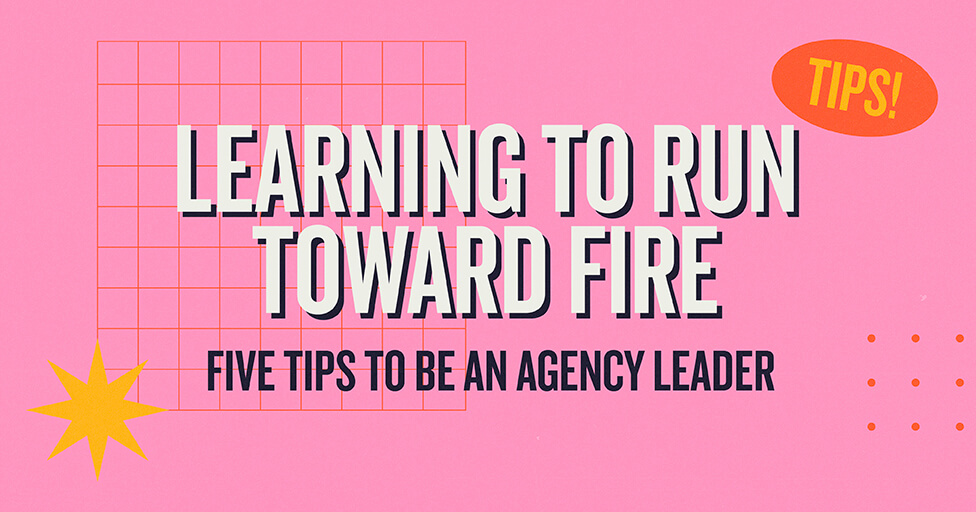
I found myself in a very interesting conversation the other day. In a marketing world full of big data, fact-based approaches, automation and ROI pressure, we found ourselves talking about something a bit less tangible: courage.
The conversation went like this.
“Our challenge is that no one really knows who we are and what we do. As a non-profit organization, our goal is both fundraising and education. The problem is, there is another, well-established organization in town that gets all of the attention and operates in the same area that we do. Not only that, there are so many other great non-profit groups out there who are all seeking support and probably talking to all of the same companies and philanthropists. In addition, we need and value the help we receive from volunteers, but when it comes to marketing, our committees tend to focus on the same old events, and old-school thinking tends to prevail. I suppose we have a hard time seeing the forest through the trees, and we struggle to tell our story.”
As I listened, and as we talked further, it became apparent that this organization is doing amazing work and has some important, life-changing stories to tell. For a variety of reasons though (including staff turnover, “we always do it this way” committee thinking, and not having anyone really assigned to thinking about the big-picture brand), they continue to play it safe and adhere to the status quo.
This organization has a clear mission. They have specific and measurable objectives. They have numerous strategies and tactics to accomplish their goals. They have piles and piles of data and research. And that’s all great. Those things are all clearly an integral part of smart marketing.
What they are missing, in my opinion, is the creative courage to push the envelope a bit and tell their story in a more human, motivating way. The “tried and true” will only get organizations so far, and in an increasingly competitive space, where other great organizations are asking the same people for donations, there is even more pressure and opportunity to connect first with the heartstrings. Connect with the heartstrings, and the purse strings will follow.
That conversation got me thinking about creative courage. In addition to data and strategy insight and everything else that goes into a great brand, can an ounce of courage take brands to another level of greatness? Perhaps you can just call it “creativity,” but as I looked for some examples, it seemed to me that some of the greatest campaigns of all time pushed beyond only being super creative. They took a risk. They pushed. Someone had the courage to say, “yes.” Below are a few examples:
Apple “1984”
The Apple “1984” commercial is perhaps the most famous TV commercial of all time. It ran twice. Once on December 31, 1983 in Idaho in order to qualify for the 1983 advertising awards season, and again in the 1984 Super Bowl. Did it work? I could never cover all of the commentary on that within this blog, but here is one excerpt:
- Super Bowl viewers were overwhelmed by the startling ad. The ad garnered millions of dollars worth of free publicity, as news programs rebroadcast it that night. It was quickly hailed by many in the advertising industry as a masterwork. Advertising Age named it the 1980s Commercial of the Decade, and it continues to rank high on lists of the most influential commercials of all time […] ‘1984’ was never broadcast again, adding to its mystique.
Ted Friedman, in his 2005 text, Electric Dreams: Computers in American Culture.
American Legacy Foundation “The Truth”
First launched in 1998 in Florida, this anti-tobacco campaign definitely pushed the creative envelope. While perhaps startling to some, courageous impact was needed to drive behavioral change. Some comments on the success of this work over time:
- In 2008, the Monitoring the Future (MTF) study, which surveys national samples of over 45,000 youth in grades 8, 10, and 12, reported historically low levels of current cigarette use amongst youth. The findings showed that smoking prevalence since 1996 decreased by two-thirds among 8th graders, by more than half among 10th graders, and by nearly half among 12th graders.
- To examine economic outcomes, a 2009 study examined whether the $324 million investment in ”The Truth” campaign could be justified by its effect on public health outcomes. The researchers found that even using conservative estimates of the campaign’s positive health impact, the campaign was economically efficient because it saved between $1.9 and $5.4 billion in medical care costs to society between 2000-2002. In this way, the authors argue “truth” is a cost-effective public health intervention.
Dove “Real Beauty”
This famous campaign also illustrates having the courage to step out beyond the traditional and expected work that was so typical in the health and beauty category. Moving beyond perfect, beautiful models was risky, but it was also courageous.
- For marketing executives, the Dove “Real Beauty” program remains a model for how to generate viral impressions and revitalize a brand. What made the “Real Beauty” program unique was that it changed the conversation about what makes women beautiful and provided multiple channels for people to participate in the discussion. Brand managers and marketing executives who want to achieve a similar result should think about adding new voices to their own brand conversation.
AT&T “It Can Wait”
And last but not least, I love the current don’t text and drive campaign from AT&T. The videos are startling and scary and so real. Time will tell if this campaign is effective, but in my opinion, if it saves one life, it will be deemed a success. P.S. Don’t text and drive. Just don’t do it.
I realize these are all famous and amazing examples. But so what? Why not keep trying to raise the bar in your own organization? My key takeaways on how to do that include:
- Strong Foundation: Courageous ideas should always start with fact-based, strategic insight.
- Simple Human Truth: Have the courage to tell it like it is. Thank you, Dove.
- Creative Courage: Strive for strategic disruptive, but every idea doesn’t have be shocking.
- Risk vs. Opportunity: Consider whether there is more risk in blending in vs. having the courage to push the envelope and stand out?
- Results: Measurable results obviously matter. This isn’t just about creativity for creativity’s sake.
So, let’s get back to my recent conversation with the non-profit organization. As we continued to talk about the amazing opportunity for growth, and as we explored stepping out of our comfort zone a bit, you could feel the discussion change. It got more exciting. We could more easily visualize real potential. We have work to do. But, just shifting the conversation to include “creative courage” opened up a new world of possibility. Now we just need the courage to do it.
For more information on how we at MBB+ use courage to Create Action, view our latest case studies.
Subscribe to our newsletter
Get our insights and perspectives delivered to your inbox.


